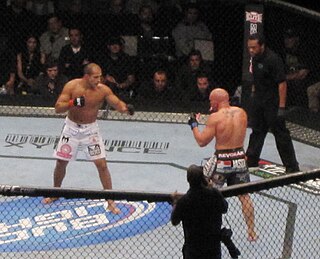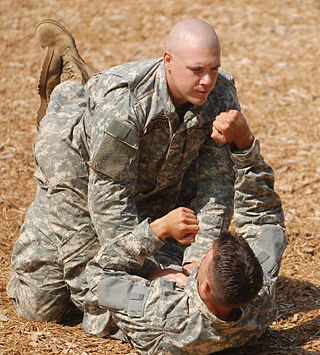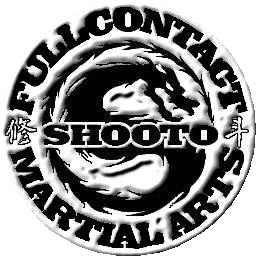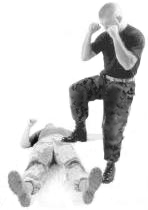
Grappling is a fighting technique as well as a full-contact combat sport based on throws, trips, sweeps, clinch fighting, ground fighting and submission holds.

Kickboxing is a full-contact combat sport and a form of boxing based on punching and kicking. The fight takes place in a boxing ring, normally with boxing gloves, mouth guards, shorts, and bare feet to favor the use of kicks. Kickboxing is practiced for self-defense, general fitness, or for competition. Some styles of kickboxing include: Karate, Muay Thai, Japanese kickboxing, Lethwei, Sanda, and Savate.

A kick is a physical strike using the leg, in unison usually with an area of the knee or lower using the foot, heel, tibia (shin), ball of the foot, blade of the foot, toes or knee. This type of attack is used frequently by hooved animals as well as humans in the context of stand-up fighting. Kicks play a significant role in many forms of martial arts, such as capoeira, kalaripayattu, karate, kickboxing, kung fu, MMA, Muay Thai, pankration, pradal serey, savate, sikaran, silat, taekwondo, vovinam, and Yaw-Yan. Kicks are a universal act of aggression among humans.

Pankration was an unarmed combat sport introduced into the Greek Olympic Games in 648 BC. The athletes used boxing and wrestling techniques but also others, such as kicking, holds, joint-locks, and chokes on the ground, making it similar to modern mixed martial arts. The term comes from the Greek παγκράτιον [paŋkrátion], meaning 'all of power', from πᾶν (pan) 'all' and κράτος (kratos) 'strength, might, power'.

Brazilian jiu-jitsu is a self-defence martial art and combat sport based on grappling, ground fighting, and submission holds. BJJ approaches self-defense by emphasizing taking an opponent to the ground, gaining a dominant position, and using a number of techniques to force them into submission via joint locks or chokeholds.

Mixed martial arts (MMA) is a full-contact combat sport based on striking, grappling and ground fighting, incorporating techniques from various combat sports from around the world. The first documented use of the term mixed martial arts was in a review of UFC 1 by television critic Howard Rosenberg in 1993.

Full contact karate is any format of karate where competitors spar full-contact and allow a knockout as winning criterion.

A strike is a directed physical attack with either a part of the human body or with an inanimate object intended to cause blunt trauma or penetrating trauma upon an opponent.

The guard is a ground grappling position in which one combatant has their back to the ground while attempting to control the other combatant using their legs. In pure grappling combat sports, the guard is considered an advantageous position, because the bottom combatant can attack with various joint locks and chokeholds, while the top combatant's priority is the transition into a more dominant position, a process known as passing the guard. In the sport of mixed martial arts, as well as hand-to-hand combat in general, it is possible to effectively strike from the top in the guard, even though the bottom combatant exerts some control. There are various types of guard, with their own advantages and disadvantages.

Lethwei or Burmese boxing is a full contact combat sport from Myanmar that uses stand-up striking including headbutts. Lethwei is considered to be one of the most brutal martial arts in the world, as the sport is practiced bareknuckle with only tape and gauze while fighters are allowed to strike with their fists, elbows, knees, and feet, and the use of headbutts is also permitted. Disallowed in most combat sports, headbutts are important weapons in a Lethwei fighter's arsenal, giving Lethwei its name of the "Art of nine limbs". This, combined with its bareknuckle nature, gave Lethwei a reputation for being one of the bloodiest and most violent martial arts. A vast majority of Lethwei fighters originate from the Karen ethnicity.

Shooto is a combat sport and mixed martial arts organization that is governed by the Shooto Association and the International Shooto Commission. Shooto was originally formed in 1985, first as a particular fighting system and then in 1989 as a mixed martial arts promotion. It is considered one of the first true mixed martial arts competitions, with its Vale Tudo Japan events being essential to the rise of PRIDE Fighting Championships and the development of modern MMA. Many Japanese MMA fighters had their start at Shooto and the organization still holds both professional and amateur tournaments.
Ricardo Arona is a Brazilian former professional mixed martial artist, submission grappler and 4th degree Brazilian jiu-jitsu (BJJ) black belt practitioner.

In martial arts and combat sports, stand-up fighting is hand-to-hand combat between opponents in a standing position, as distinguished from ground fighting. Clinch fighting is stand-up grappling. Fighters employ striking, including striking combinations, using either body parts or mêlée weapons, to incapacitate or injure the opponent. Combatants use blocking techniques to block the opponent's attacks.

An elbow strike is a strike with the point of the elbow, the part of the forearm nearest to the elbow, or the part of the upper arm nearest to the elbow. Elbows can be thrown sideways similarly to a hook, upwards similarly to an uppercut, downwards with the point of the elbow, diagonally or in direct movement and in several other ways, like during a jump. Elbow strikes are native to the traditional Southeast Asian martial arts, traditional Chinese martial arts and traditional Okinawan martial arts.

A knee strike is a strike with the knee, either with the kneecap or the surrounding area. Kneeing is a disallowed practice in many combat sports, especially to the head of a downed opponent. Styles such as kickboxing and several mixed martial arts organizations allow kneeing depending on the positioning of the fighters. Knee strikes are native to the traditional Southeast Asian martial arts and traditional Okinawan martial arts.

Clinch fighting is the part of stand-up fighting where the combatants are grappling in a clinch, typically using clinch holds. Clinching the opponent can be used to eliminate the opponent's effective usage of some kicks, punches, and melee weapons. The clinch can also be used as a medium to switch from stand-up fighting to ground fighting by using takedowns, throws or sweeps.

A grappling position refers to the positioning and holds of combatants engaged in grappling. Combatants are said to be in a neutral position if neither is in a more favourable position. If one party has a clear advantage such as in the mount they are said to be in a "dominant position". Conversely, the other party is considered to be in an inferior position, usually called "on the bottom", but in this case sometimes called the "under mount".

A soccer kick, also known as a soccer ball kick or PK in puroresu and shoot fighting, and as tiro de meta in vale tudo, is a reference to a kick that is similar to kicks used in association football. It is the colloquial term for a kick performed against a prone, kneeling, rising or supine opponent by a fighter who is in a standing or semi-standing position, to any part of a downed opponent. The technique is banned under the Unified Rules of Mixed Martial Arts; however, other rulesets, including the ones used by Pride Fighting Championships do permit them. Soccer kicks have been regularly discussed as to potential damage. There has been a regular debate on the usage of them within MMA. Some MMA fans and fighters support them while a fight doctor and politicians have opposed them.

Cage Rage Championships, also known as Cage Rage, was a United Kingdom-based, mixed martial arts promotion that premiered on 7 September 2002 in London. Cage Rage went into liquidation and is now no longer trading. Cage Rage had been owned and managed by Elite XC until that company ceased operating, and the British promoters behind Cage Rage formed a new organization and withdrew all the old Cage Rage titles. Matchmaker and on-screen personality Dave O'Donnell was also a minority shareholder in the company. Fellow on-screen personality and co-promoter Andy Geer also owned a minority stake until he left the promotion in 2008. Cage Rage events were replayed on Nuts TV, along with their own weekday show on The Fight Network until these channels closed down. Every Cage Rage event and bout is now archived as part of the UFC Fight Pass library.
Most rule sets for mixed martial arts (MMA) competitions have evolved since the early days of Vale Tudo. As a result of health, legal, and moral concerns, many different rulesets were created, which give different countries and promotions very different tactics and strategies. Similarly, shoot wrestling organizations, such as Shooto, expanded their rulesets to integrate elements of Vale Tudo into their sport. However, for the most part, fighters accustomed to one rule set can easily acclimate to the others.

















